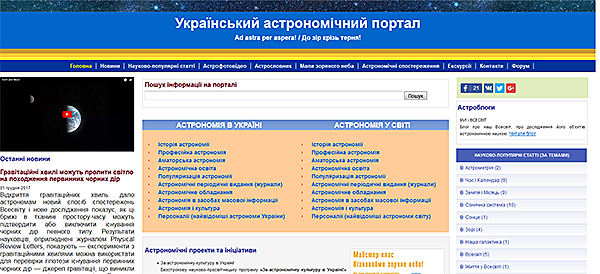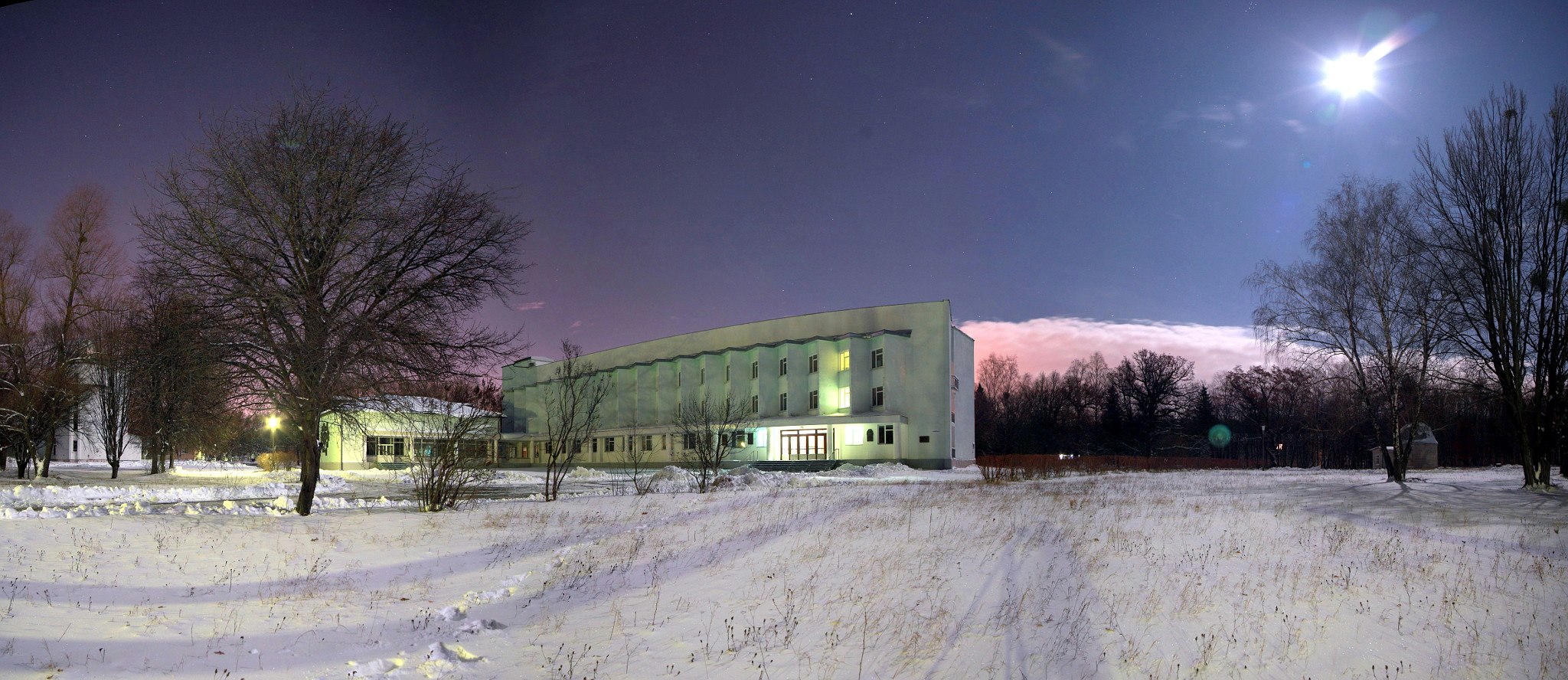Лабораторія створена в 1983 р.
Співробітники лабораторії:
| Жиляєв Борис Юхимович | зав.лаб., д.ф.-м.н. | zhilyaev(at)mao.kiev.ua | кімн. 324, тел. 3-21 |
| Решетник Володимир Миколайович | с.н.с., к.ф.-м.н. | ||
| Верлюк Ірина Адамівна | Н.с. | irina(at)mao.kiev.ua | кімн. 324, тел. 3-21 |
| Похвала Сергій Миколайович | М.н.с. | ||
| Пєтухов Володимир Миколайович | Пров. інженер |
Основні напрями наукових досліджень:
- Швидкісна спектрофотометрія гігантів типу OBA
- Дослідження високочастотної оптичної змінності зірок, що спалахують.
- Швидка фотометрична анатомія метеорів.
- Виявлення високочастотної змінності з дефіцитом квантів.
Наукові досягнення
✔ Pokhvala S.M. "Short-Term Spectroscopic Variability in O-type Giants"
The work solved the problem of finding the intrinsic variability in the lines of the spectrum of hot stars, by taking into account the difference in the intrinsic variability spectra and the noise distribution spectrum. Phase discrimination allows one to free the light curve of the spectral lines from spurious harmonics provoked by interference due to variations in atmospheric transparency and guiding errors.
A method is proposed for constructing maps of spectra, a matrix calculated from an array of observations of spectra, the rows of which are wavelengths and the columns are the power spectra of intensity variations. Spectrum maps allow us to find islands of activity, which is characterized by the coordinates of the wavelength - the oscillation period. The position of the island relative to the center of the spectral line determines its offset Δλ. Hence, in the case of the stellar wind, one can determine the wind speed and oscillation frequency at the point of their existence. The width of the island is related to the wind flow geometry. It can be judged on whether the wind is a spherically symmetric phenomenon or a directional flow.
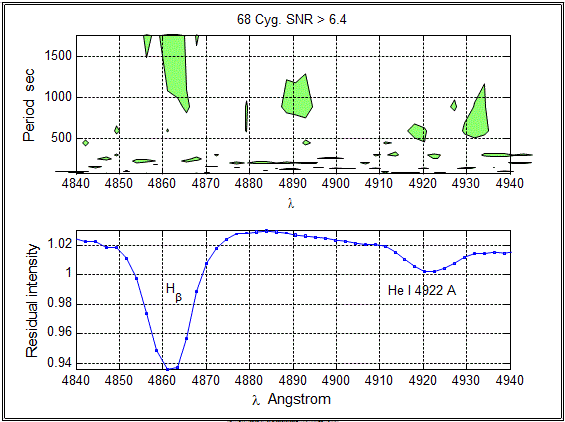
Figure 1. The map of spectra of 68 Cyg in the vicinity of the Hβ line.
In Fig. 1 one can see the developed activity in the Hβ line and the helium line He I 4922 Å of the hot giant 68 Cyg (HD 203064), an O7.5 III:n((f)) star. The low-frequency variations in the H? line have three components: the central and two offset red and blue islands shifted by 5 angstroms. The helium line He I 4922 Å has a central island and a red island shifted by 12.5 angstroms, which corresponds to a wind speed of 762 km/s. Island of activity with a period of about 1000 seconds is probably associated with a weak depression in the vicinity of 4890 Å.
The proposed technique allows us to restore the light curves of the active lines, to monitor their variations over time.
✔ Verlyuk I.A. "SMALL-SCALE ACTIVITY OF THE FLARE STAR YZ CMI"
For the first time periodic pilot signals have been detected in a quiet state of the flaring star YZ CMi, that control the flares of the star. Their amplitude is small, a few hundredths of a magnitude in U rays (Figs 1 – 3).
Both small and large flares appear at the maxima of the pilot signals.
Thus, the flare activity of a star is not a random, but some deterministic process that can be predicted.
This effect was detected at YZ CMi by Irina Verlyuk according to observations at the 2-m telescope at peak Terskol in 2007 and 2012.
This effect is a new phenomenon that is not taken into account in modern theories of stellar flares.
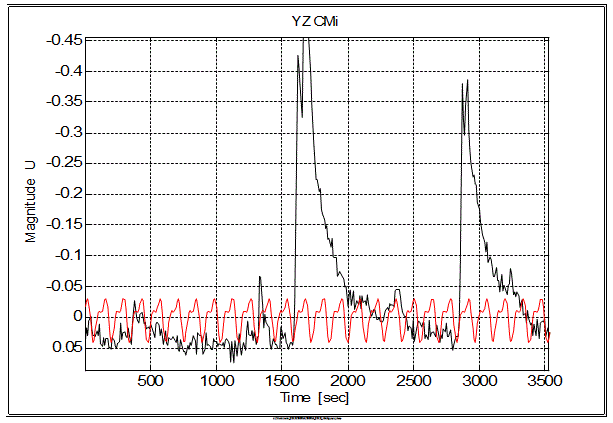
Figure 1. YZ CMi flares on March 14, 2007. The flares and high-frequency oscillations in them are synchronized by the pilot signal.

Figure 2. YZ CMi flare on March 14, 2007. The flares are initiated by the front of the pilot signal.
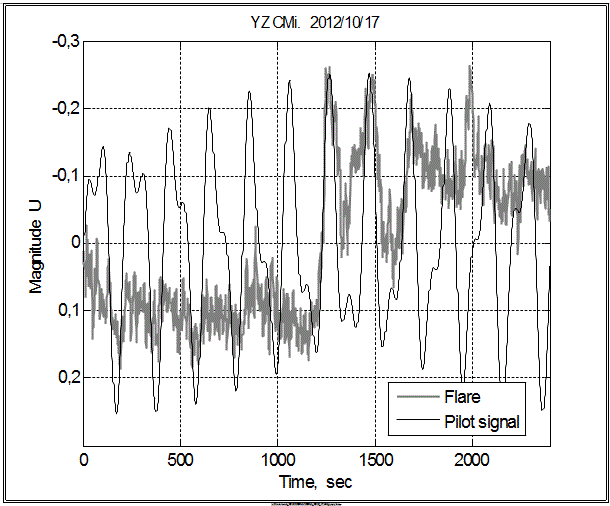
Figure 3. YZ CMi flare on October 17, 2012. The flare and high-frequency oscillations in it are synchronized by the pilot signal. The scale of the signal is increased for convenience.
✔ B.E. Zhilyaev, S.M. Pokhvala. "High-frequency photometric anatomy of meteors"
Analysis of meteor observations showed that their brightness fluctuates with a frequency of several hertz. The magnitude of the variability is several thousandths of a magnitude. In addition, there is a “wobbling” with a frequency of several hertz. It was decided to check whether these effects are in the tracks of meteors obtained by other authors. Leonid-meteor-6230 (Leonid 6230 by Mike Hankey) [1] was selected (Fig 1). Below are the results of a photometric analysis of a meteor track.
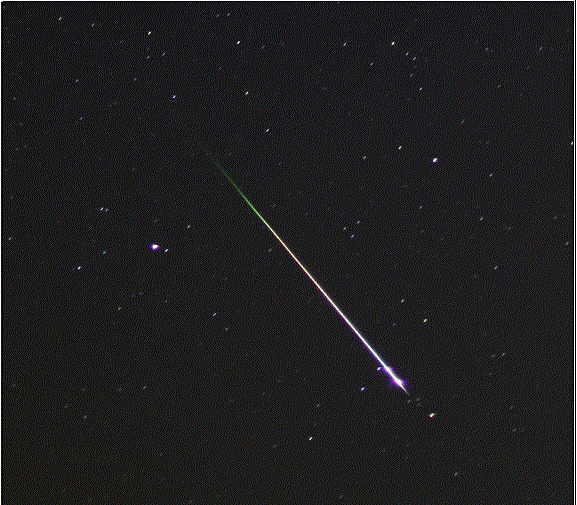
Figure 1. Leonid-meteor-6230 [1]
The position of the meteor on the color diagram (B - V) - (V - R) allows us to determine the temperature of the meteor plasma. If the plasma is optically thick, it shines like a completely black body (Fig 2).
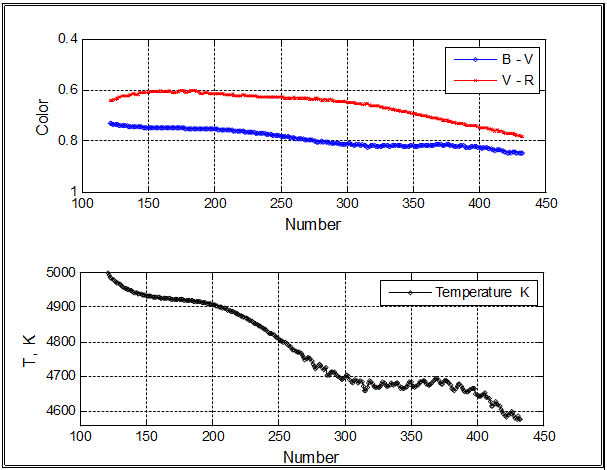
Figure 2. Variations of the temperature of the meteor plasma.
The meteor temperature varies from 4920 K to 4572 K. Two features of the meteor temperature variation are clearly visible: (1) a wave with a period of about 0.4 s and amplitude of about 50 K; (2) and high-frequency temperature ripples with amplitude of about 15 K.
A time spectral analysis of the meteor light curves, as well as the position of the center of mass of the integral light curve, reveals two significant harmonics around 3 and 46 Hz. This allows us to restore both the light curve of the meteor and the characteristics of the “wobbling” on the flight path.
The meteor light curve has a clearly defined harmonic wave with a frequency of 3 Hz and high frequency variations with a frequency of 46 Hz (Fig 3).
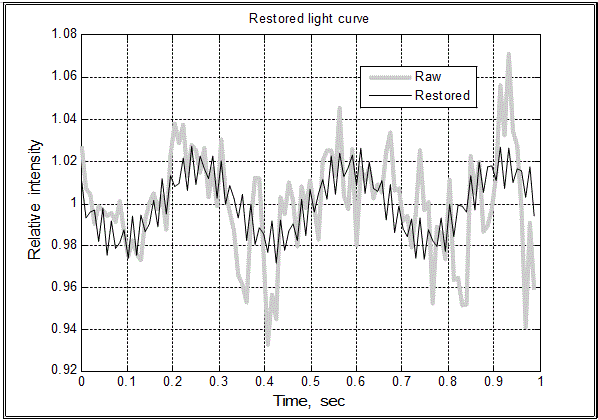
Figure 3. The meteor light curve.
The main oscillations of the brightness and the “wobbling” of the meteor track are observed at a frequency of about 3 Hz. Variations of brightness in the integral light are about 0.03 magnitudes (3%). The amplitude of “wobbling” is about 1% of the width of the meteor track (Fig 4).
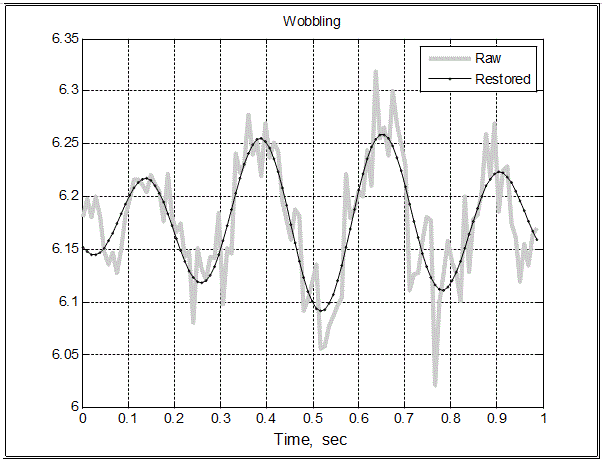
Figure 4. The “wobbling” of the meteor track.
Note that the archives of observations of meteors contain a huge array of data that no one has processed by the method proposed above. This technique opens a new trend in the physics of meteors.
References
[1] Leonid 6230 by Mike Hankey www.amsmeteors.org
✔ B.E. Zhilyaev. "Detection of ultra-high-frequency variability with a deficit of quanta"
A technique for detecting harmonics in sparse quantum flows is developed when it is impossible to describe a light curve. A problem that is insoluble in the time representation can be exactly solvable in the Fourier frequency representation. We demonstrate the application of the described technique to the analysis of gamma-ray flare from the Compton Gamma Observatory CGRO. In the BATSE trigger No. 207 in an energy channel of 25-50 keV with flare duration of 0.030 ± 0.002 s, two significant harmonics at 190 and 310 kHz with half-widths of about 25 kHz are fixed, which correspond to velocities of 25,000 km / sec (~ 0.08 speed of light). The size of the object is estimated to be ~ 6000 km, and the size of the active region is ~ 484 km.
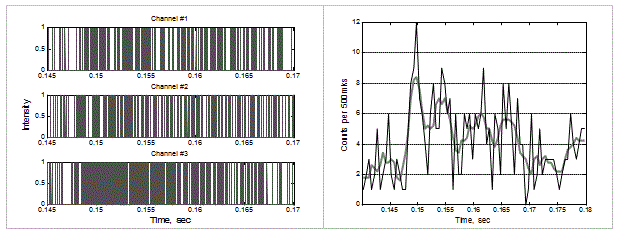
Fig 1. Left: Initial (raw) light curves in the region of the flare. The degree of filling (Poisson's intensity) averages about 0.003. Right: Smoothed light curve in the first energy channel (25-50 keV). The fluctuations in the brightness of the flare with a frequency of about 180 Hz are clearly visible.
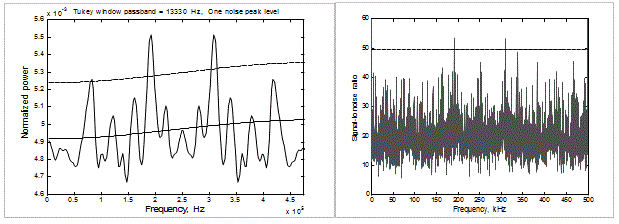
Fig 2. Left: Power spectrum in the flare region is shown. The dashed curve corresponds to the detection of a harmonic by the criterion "One noise peak". Right: The Fourier power spectrum after filtering with a frequency window of width n = 10. The detection boundary at the significance level "One noise peak" is shown by a dashed line.
A possible scenario for gamma-ray flare is the merger of black holes of stellar mass and neutron stars [1]. During the coalescence process, the substance circulating around the black hole demonstrates rapid fluctuations in the radiation intensity. Such a system will also emit gravitational waves, which lead to a decrease in the radius of the orbit. The time scale of the coalescence process is from several milliseconds to several tens of milliseconds.
✔ B.E. Zhilyaev. "Detection of ultra-high-frequency variability with a deficit of quanta"
A technique for detecting harmonics in sparse quantum flows is developed when it is impossible to describe a light curve. A problem that is insoluble in the time representation can be exactly solvable in the Fourier frequency representation. We demonstrate the application of the described technique to the analysis of gamma-ray flare from the Compton Gamma Observatory CGRO. In the BATSE trigger No. 207 in an energy channel of 25-50 keV with flare duration of 0.030 ± 0.002 s, two significant harmonics at 190 and 310 kHz with half-widths of about 25 kHz are fixed, which correspond to velocities of 25,000 km / sec (~ 0.08 speed of light). The size of the object is estimated to be ~ 6000 km, and the size of the active region is ~ 484 km.

Fig 1. Left: Initial (raw) light curves in the region of the flare. The degree of filling (Poisson's intensity) averages about 0.003. Right: Smoothed light curve in the first energy channel (25-50 keV). The fluctuations in the brightness of the flare with a frequency of about 180 Hz are clearly visible.

Fig 2. Left: Power spectrum in the flare region is shown. The dashed curve corresponds to the detection of a harmonic by the criterion "One noise peak". Right: The Fourier power spectrum after filtering with a frequency window of width n = 10. The detection boundary at the significance level "One noise peak" is shown by a dashed line.
A possible scenario for gamma-ray flare is the merger of black holes of stellar mass and neutron stars [1]. During the coalescence process, the substance circulating around the black hole demonstrates rapid fluctuations in the radiation intensity. Such a system will also emit gravitational waves, which lead to a decrease in the radius of the orbit. The time scale of the coalescence process is from several milliseconds to several tens of milliseconds.
✔ B. Zhilyaev, V. Reshetnyk, V. Petukhov. "On reconstruction of astronomical images in observations through turbulent atmosphere "
Atmospheric turbulence distorts the wavefront of the light wave. This results in degradation of the image, loss of angular resolution, which can be from one to several arc seconds.
We exhibit the technique for reconstruction of astronomical images, obtained during observations through a turbulent atmosphere [1].We use combined method, which includes: averaging of centered images; the filtration of their Fourier transforms by the inverse optical transfer function for the Kolmogorov model of atmospheric turbulence, and subsequent inverse Fourier transform. We use observational data from the high-speed CMOS camera on the Zeiss-600 telescope of Andrushevska Observatory with an exposure time of 0.01 sec and a shooting frequency of 30 frames per second.
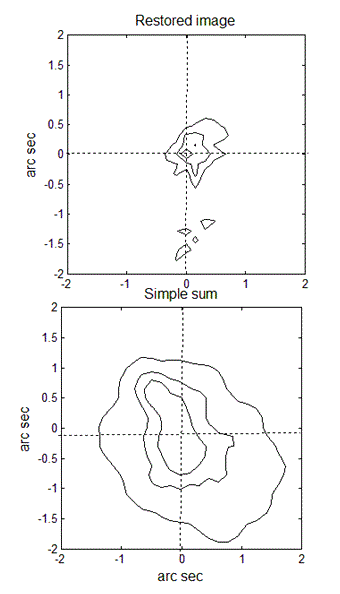 |
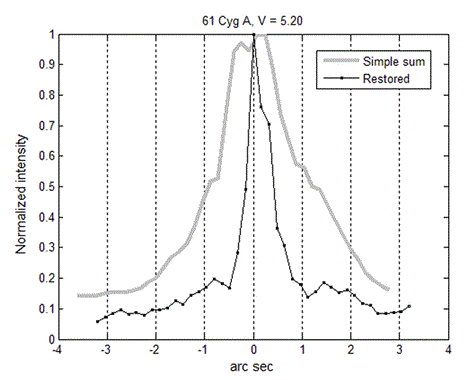 |
| Figure 1. (Left picture). Contour images of the star 61 Cyg A, reconstructed (top picture) and with an exposure of 1 second (lower figure). (Right picture) Photometric sections of the star images 61 Cyg A, FWHM = 2.28 arc second (exposure 1 sec), FWHM = 0.65 arc second (reconstructed image). |
The images of the 61 Cyg A star reconstructed in 100 consecutive frames (FWHM = 0.65 arc second) and with an exposure of 1 second (FWHM = 2.28 arc second) and their photometric sections are shown in Fig. 1. The images are normalized to unit intensity at the maximum.
We show that the angular resolution can be improved up to the diffraction limit for observations made on small telescopes.
References
[1] B. Zhilyaev, V. Reshetnyk, V. Petukhov, On reconstruction of astronomical images in observations through turbulent atmosphere, 2018, Bulgarian Astronomical Journal 29, 67-73
astro.bas.bg/AIJ/.../BZhilyaev.pdf



 НОВЕ НА САЙТІ
НОВЕ НА САЙТІ



